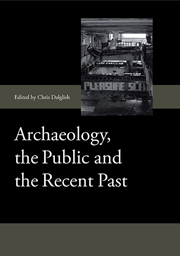Book contents
- Frontmatter
- Contents
- List of Figures and Tables
- List of Contributors
- Archaeologists, Power and the Recent Past
- Part One Constructing Memories, Constructing Communities
- Open-Air Museums, Authenticity and the shaping of Cultural Identity: An Example from the Isle of Man
- Loyal yet Independent: Archaeological Perspectives on Remembering and Forgetting World War I on the Isle of Man
- Public Engagement at Prestongrange: Reflections on a Community Project
- Archaeology for All: Managing Expectations and Learning from the Past for the Future – the Dig Manchester Community Archaeology Experience
- Rediscovering, Preserving and Making Memories at Community Archaeology
- Part Two Engaging the Past, Engaging the Present
- Index
Archaeology for All: Managing Expectations and Learning from the Past for the Future – the Dig Manchester Community Archaeology Experience
from Part One - Constructing Memories, Constructing Communities
Published online by Cambridge University Press: 05 September 2013
- Frontmatter
- Contents
- List of Figures and Tables
- List of Contributors
- Archaeologists, Power and the Recent Past
- Part One Constructing Memories, Constructing Communities
- Open-Air Museums, Authenticity and the shaping of Cultural Identity: An Example from the Isle of Man
- Loyal yet Independent: Archaeological Perspectives on Remembering and Forgetting World War I on the Isle of Man
- Public Engagement at Prestongrange: Reflections on a Community Project
- Archaeology for All: Managing Expectations and Learning from the Past for the Future – the Dig Manchester Community Archaeology Experience
- Rediscovering, Preserving and Making Memories at Community Archaeology
- Part Two Engaging the Past, Engaging the Present
- Index
Summary
This paper provides an overview of the ‘I Dig Moston'/‘Dig Manchester’ community archaeology project, which took place in Manchester, England, between 2003 and 2008. This project involved the collaboration of local residents, school children, community groups and professional archaeologists from the University of Manchester Archaeological Unit and the Manchester Museum. The paper reviews the power structures and relationships which characterised the project, with reference to Arnsteins ‘ladder of citizen participation’. It reviews the aims and impacts of the work, reflecting on methods for the evaluation of community archaeology initiatives.
INTRODUCTION
This paper provides an overview of a five-year project that began life under the banner of ‘I Dig Moston’ in 2003 and finished as ‘Dig Manchester’ in 2008. Two seasons of highly successful community excavations at the site of Moston Hall in Broadhurst Park, northern Manchester, encouraged both the volunteers and professionals involved to apply for Heritage Lottery funding to deliver community archaeology across the city from 2005 to 2008 (Fig. 4.1). Through Dig Manchester, local residents, school children and community groups worked alongside professional archaeologists from the university of Manchester Archaeological unit and the Manchester Museum on a programme of educational activities and community excavations. Four historic sites, all on council-owned land, were chosen for investigation. In 2005 the project continued the work begun by I Dig Moston in northern Manchester and completed the excavation of Moston Hall. In 2005 and 2006 excavations were carried out in southern-central Manchester which revealed the remains of Northenden Mill on the banks of the River Mersey.
- Type
- Chapter
- Information
- Archaeology, the Public and the Recent Past , pp. 65 - 76Publisher: Boydell & BrewerPrint publication year: 2013



